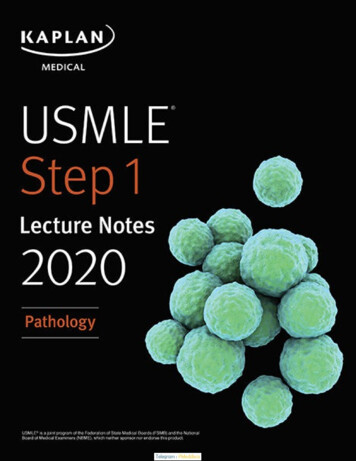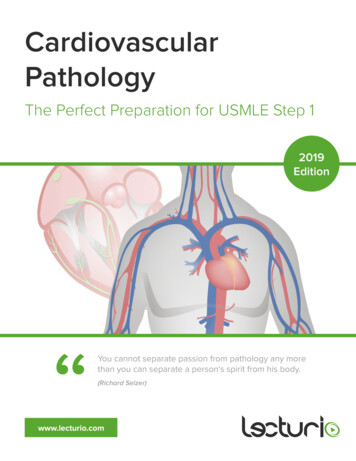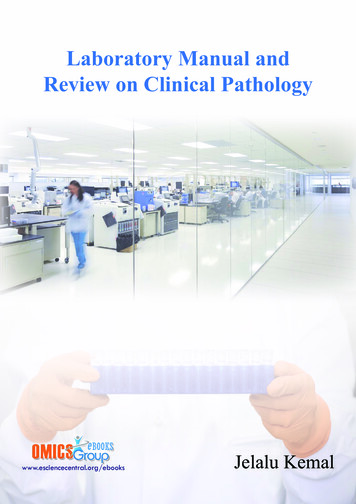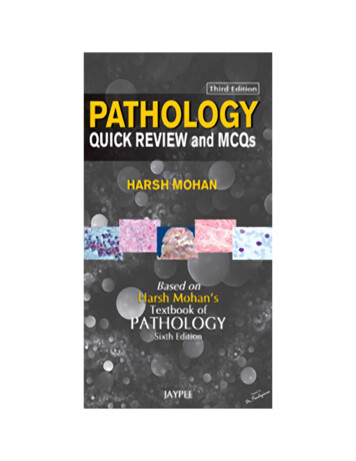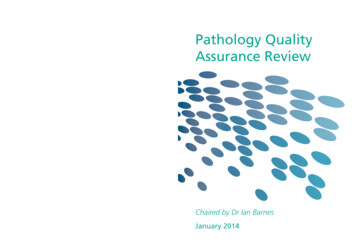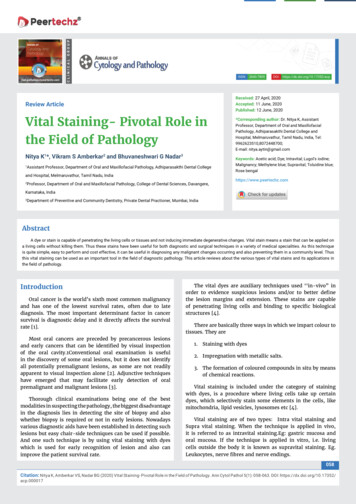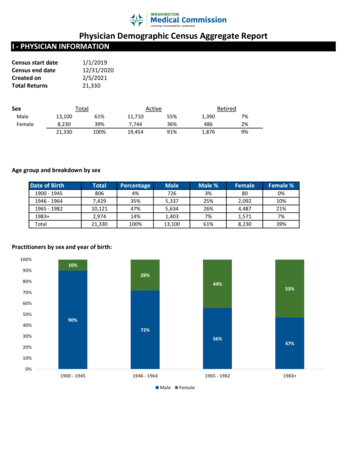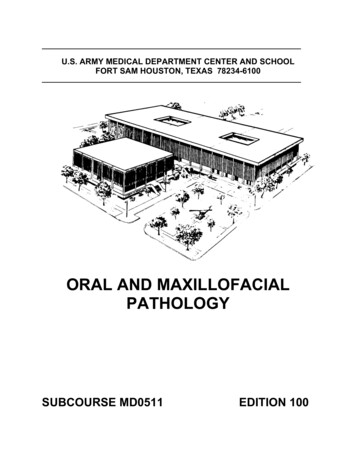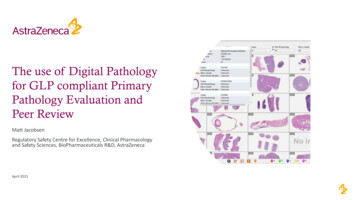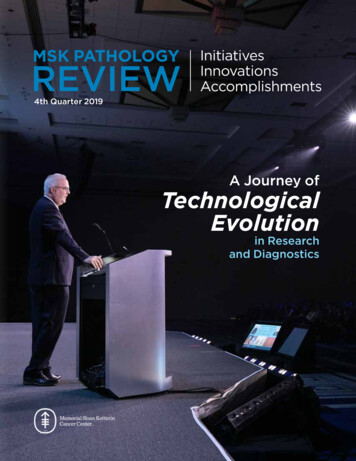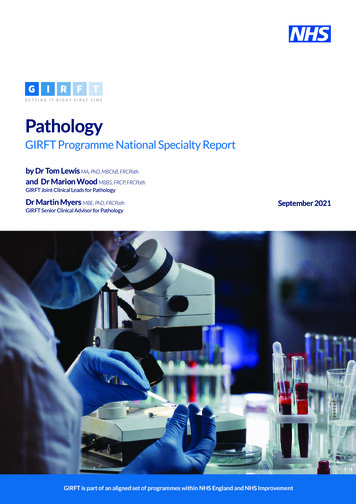
Transcription
PathologyGIRFT Programme National Specialty Reportby Dr Tom Lewis MA, PhD, MBChB, FRCPathand Dr Marion Wood MBBS, FRCP, FRCPathGIRFT Joint Clinical Leads for PathologyDr Martin Myers MBE, PhD, FRCPathGIRFT Senior Clinical Advisor for PathologySeptember 2021GIRFT is part of an aligned set of programmes within NHS England and NHS Improvement
ContentsForeword from Professor Tim Briggs, GIRFT Programme Chair.3Introduction by Dr Tom Lewis, Dr Marion Wood and Dr Martin Myers .4Statements of support .6Executive summary .7Overview of recommendations.15Core recommendations .15Detailed recommendations .17Pathology today .21What is pathology? .21Current service organisation.21About our analysis .22Data sources .23What is covered in this report.24Learning from past initiatives.24The Barnes Review.24The Carter reports.25The main sections of the report .25Findings and recommendations.26End-to-End Pathology: improving quality across the health system.26The Clean Framework.27Clean in .27Clean through.56Clean out.63Applying the Clean Framework to end-to-end pathways for a sentinel condition .76The three foundations underpinning the Clean Framework.82Minimising error and wastage in blood transfusion.112Workforce.114Finance.127Litigation .129Notional financial impact.132About the GIRFT dix 1: The coronavirus pandemic and lessons for pathology services .146Appendix 2: CA125 testing: a candidate for network standard development.150Appendix 3: PSA testing: another candidate for network standard development .151Appendix 4: Example of decision aid to help clinicians interpret results.1522
Foreword from Professor Tim BriggsI am delighted to recommend this Getting It Right First Time review of pathology, led by Tom Lewis, Marion Wood andMartin Myers.This report comes at a time when the NHS has undergone profound changes in response to the COVID-19 pandemic.The unprecedented events of 2020/21 – and the extraordinary response from everyone working in the NHS – add greatersignificance to GIRFT’s recommendations, giving many of them a new sense of urgency. Reliable testing has been a centralfocus of the UK’s pandemic response, and so has rarely been out of the headlines.The key requirements for pathology during this pandemic reflect the priorities highlighted in this report. The recommendationsset out here will help to ensure that people get the right test at the right time, with the right answer.Tom, Marion and Martin have applied the GIRFT approach to their field, which provides expertise underpinning every aspectof patient care across all areas of healthcare, from diagnostic testing to treatment advice. Pathology covers a broad range ofspecialties, including the key areas of haematology, clinical biochemistry, microbiology and histopathology. Pathologists oftenlead scientific and medical advancement through their research, and the specialty itself is undergoing rapid and exciting change.The recommendations set out in this report are based on the visits that the clinical leads made to labs and pathology networksacross England, in addition to other data and audits. The recommendations cover the whole of the pathology pathway, from aclinician’s decision to order a test, through the sample’s journey to the lab, to the results being delivered to the requestor andunderstood by the patient. These recommendations will help to ensure that the request-result cycle works smoothly andefficiently, facilitated by – and yielding – more readily accessible and useful data.Tom, Marion and Martin have found examples of excellence in every lab or centre they visited, and also opportunities forimprovement. Like other clinical leads before them, they have found that their colleagues were dedicated to qualityimprovement work and an ambition to make a tangible, lasting difference to patient care.That commitment and ambition is vital to the GIRFT programme, which can only succeed with the backing of clinicians,managers and everyone involved in delivering care.My greatest hope is that GIRFT will provide support and impetus for all those involved in pathology to work shoulder toshoulder and continue making a real difference in patients’ lives, while ensuring that the service is ready and resilient to facethe challenges and fascinating opportunities to come.Professor Tim Briggs CBEGIRFT Programme Chair and National Director of Clinical Improvement for the NHSProfessor Tim Briggs is Consultant Orthopaedic Surgeon at the Royal National OrthopaedicHospital NHS Trust, where he is also Director of Strategy and External Affairs. He led the firstreview of orthopaedic surgery that became the pilot for the GIRFT programme, which he nowchairs. Professor Briggs is also National Director of Clinical Improvement for the NHS.3
Introduction by Dr Tom Lewis, Dr Marion Wood andDr Martin MyersThroughout our time with GIRFT, we have been hugely impressed by our pathology colleagues around the country, andwe are very grateful to them for their commitment to this project: from providing the data that formed the backbone of ourdeep-dive visits, to the welcome and interest shown as we undertook those visits – all in spite of the immense pressures wehave seen colleagues working under, magnified several-fold by the many impacts on pathology from the COVID-19pandemic.Pathology is critical to patient care, but may sometimes be viewed as simply a result-generating service. Where pathologyis viewed in this way, it can make pathologists focus inward, on the processes within the lab.In this project we have seen – and encourage others to see – pathology as an end-to-end service, starting with the clinicalencounter that leads to the right test being requested, and ending with the right results going back to the right patient inthe right timeframe. This broader perspective recognises the impact that activities outside the lab’s walls have on the process,and the importance for pathologists of using their expert knowledge to extend their influence beyond the lab. If they can dothis, they will ensure that correctly requested samples arrive in the best possible condition for testing, and improve thequality and timeliness of results.We have seen fantastic examples where lab staff have worked closely with colleagues in primary care and the hospital,developing innovative solutions to common challenges such as transport, phlebotomy and centrifugation.Pathology in the UK has a long history of measuring and delivering quality; the specialty is unique in having independentlyverified quality accreditation procedures already established in every lab. This infrastructure means there are excellentfoundations for the specialty to build on to strengthen quality throughout the end-to-end process. As a result of ourdiscussions and research, we have already begun conversations with the UK Accreditation Service (UKAS) about howbroadening its approach can work for labs as they seek to influence areas beyond their traditional focus. This is an excitingoutcome of the GIRFT process, and we are especially looking forward to seeing this develop further in the near future.In our visits, colleagues have particularly valued the ability to see the variation in current practice. Seeing this data hasenabled them to compare themselves with peers and understand underlying causes of variation. However, much of the datato enable these comparisons was not readily available when we started out, and we had to gather some of it via aquestionnaire; in many cases, staff spent considerable time manually accessing local data to provide the information thatwe had requested. The adverse impact on the delivery of excellence in pathology due to the lack of consistently good data,data standards and digital systems across the service in England has been emphasised by our findings. We are thereforeencouraged that NHS England and NHS Improvement is already exploring how to work with NHSX and NHS Digital toaddress this as a matter of urgency.The pathology specialty has been going through yet another period of significant change as individual trust departmentscome together to form networks. This journey has been more difficult in some areas than others, and inevitably the rate ofprogress is variable.We have been able to share learning from those who are further along the road with those who are just starting out. Whenexamining progress, it has been clear to us that an essential component in the success of developing networks is excellencein the leadership and governance of these new organisations, with individuals who are willing to challenge and change,accepting – seeking out – responsibility rather than believing that it is outside their control.Of course, no improvement is possible without the workforce to initiate, deliver and sustain it, and alongside many otherspecialties, pathology has a capacity shortfall that must be filled. However, unlike other specialties, we are fortunate to havea large, adaptable and willing pool of talent in the biomedical scientist workforce, and as a specialty we must focus on workingtogether differently to make the most of this unique resource.4
By embracing more flexible career paths, we can both expand the workforce and ensure that pathology continues to be adynamic and satisfying career, with an exciting and fulfilling future. Discussions with the Royal College of Pathologists(RCPath) and Institute of Biomedical Science (IBMS) are already taking place, and we know that both share our enthusiasmto create a more flexible working environment – one that will ready pathology for whatever the future may bring.There are extraordinary, and challenging, times ahead. But we are hugely encouraged by the resilience, adaptability andopen-mindedness that we witnessed throughout this remarkable year. If we can harness the tenacity and creative energythat we saw in abundance during our visits, we are sure that pathology will meet those challenges head on.Dr Tom LewisGIRFT Joint Clinical Lead for PathologyTom is a consultant microbiologist at Northern Devon Healthcare NHSTrust. As lead clinician for antibiotic stewardship, he has been involved ininterventions to improve prescribing habits, focusing in particular on thebehavioural science behind this. He has a particular interest in howpathology can be used to redesign health systems.Dr Marion WoodGIRFT Joint Clinical Lead for PathologyMarion has been a consultant clinical and laboratory haematologist for25 years. She has undertaken several other management roles, includingmedical director at Colchester University Hospital NHS FoundationTrust. She is a past chair of the Council of the Association of ClinicalPathologists and a member of the Pathology Alliance.Dr Martin MyersGIRFT Senior Clinical Advisor for PathologyMartin is a consultant clinical biochemist at Lancashire TeachingHospitals NHS Foundation Trust, and associate divisional medicaldirector for pathology, having previously been clinical director ofpathology for 14 years. He is also the lead scientist for the trust.5
Statements of supportThe Royal College of PathologistsThis is an ambitious report from the GIRFT team and we commend them for their thorough and comprehensive review ofpathology services across England. The detailed route map to improve pathology services set out by the team, led by DrTom Lewis, Dr Marion Wood and Dr Martin Myers, is one we fully support. Pathology services are central to the delivery ofhealthcare. Without the right test, at the right time, with the right answer, safe and effective patient care cannot be delivered.We particularly welcome the report’s emphasis on high quality end-to-end pathology services focused on patients’ needs.The principles of supporting best clinical working practice, building single-service, mutually supportive teams, andfuture-proofing pathology with strong data and digital foundations are central to the College’s mission of supporting ourmembers to deliver excellence in pathology practice for the benefit of the public.The report advises investment in the workforce; this will be essential to implement its recommendations. Pre-pandemicdemand for pathology services had been growing year on year, and these existing workforce pressures have been furtherexposed by the COVID-19 crisis. Having the right number of staff in the right places will be key to the delivery of this report’sambitious vision to build an agile and resilient pathology service with patients at its heart.Dr Michael Osborn MRCS, FRCPathPresidentNational Specialty Advisor for Pathology, NHS England and NHS ImprovementI am pleased to see this review of pathology services by the GIRFT programme, with a focus on quality assurance, minimisingerrors, and delivering a pathology service that always supports patients, together with their clinicians, in making informeddecisions about their treatment and care. Data and evidence collection are key tools in ensuring that we review and reflecton what we do, and how we do it, in all areas of clinical practice. This GIRFT report, as with all GIRFT reports, is importantto help us in this continuing drive to improve our services.Prof Jo Martin MA, PhD, RCPathME, FIBMS(Hon), FRCPI(Hon), FRCPathProfessor of Pathology, Queen Mary University of London6
Executive summaryWhat is pathology?Pathology is the study of disease. Staff working in pathology study cells, tissues, blood and other fluids from patients’ bodiesto investigate, diagnose and monitor disease, and to guide clinicians in treatment.Pathology tests are requested by providers in primary care, the community, and secondary care. Pathology labs in Englandcarry out 1.12 billion tests per year – roughly 20 tests per person in England each year – representing 2.2 billion of NHSfunding.1Current service organisationIn England, 141 trusts include a pathology lab. Most hospitals have a pathology lab; others are supported by labs within apathology network.Most hospital labs include the ‘major’ pathology specialties of haematology (including blood transfusion), clinicalbiochemistry, microbiology and cellular pathology (also called histopathology), which are the focus of this report.The pathology workforce is primarily made up of medically qualified pathologists, clinical scientists and biomedical scientists,working in multidisciplinary teams (MDTs) across the pathology specialties.End-to-End Pathology: improving quality across the health systemEnd-to-End Pathology aims to widen the focus of the pathology service to encompass the entire service, from a clinicianconsidering a test to the patient’s interpretation of results. It focuses on answers – the right test, at the right time, with theright answer.This involves recommendations that include associated services as well as what happens within the lab itself.This will enable us to centre the service on answering the patient’s two most important questions: Am I ok? and Can I trustyour answer?From previous research, we can generate a universal purpose statement for pathology:To help people who need tests, and the people caring for them, make informed decisions about that care.We call this the outside-in way to judge success, looking at how patients and clinicians can use and understand tests, ratherthan the inside-out view, defining success according to criteria such as cost or internally derived accreditation standards.The Clean FrameworkWe created an overarching quality framework helping networks and labs to widen their focus to include the pre-analyticaland post-analytical stages of the diagnostic pathway.Clean inAre the tests appropriate?We look at approaches to ensuring:there is a valid clinical question; andthe tests are necessary, appropriate and sufficient to address that clinical question.Variation in requesting of common analytesWe saw variation in how primary care providers and emergency departments (EDs) requested tests for common analytes(substances being measured).We make specific recommendations for different analytes, but also recommend that labs implement Care Sets to improveconsistency and reduce redundancy in many common tests.1NHS Improvement: works7
Using Care SetsCare Sets are groups of tests focused around a clinical question, which the requestor can usually select with a single click.There are multiple benefits to using Care Sets, especially in reducing error and redundancy, and improving shared decisionmaking.We recommend that pathology networks:establish Care Sets throughout their network and promote these to requestors;monitor, review and update the Care Sets, taking on board feedback.To establish Care Sets, providers will need electronic requesting systems in place.Creating consistency in Care SetsWe recommend that Care Sets are built into the creation of network-wide standards (see Establishing network-wide standardsand standardised national diagnostic pathways on page 82), and that networks then monitor, review and revise these Care Sets.Using common testing profilesWhere Care Sets are not yet in place, tests are often requested as part of a group, or test profile, such as urea and electrolyte(U&E) tests. Testing profiles may introduce over-requesting by including tests that are unnecessary to answer the clinicalquestion. We found wide variations in the tests included in various common testing profiles and recommend auditing andremoving redundant tests, especially from high-volume profiles, which will free up significant lab capacity and saveunnecessary expenditure.We believe testing profiles should be replaced with Care Sets in the longer term; however, as profiles are currently incommon use and will still be required in some situations, there will still be benefit in adjusting the profiles.Avoiding unnecessary repeat tests: minimum retest intervalsSome test results are unlikely to change over short to medium timescales, and so retests within those timescales areunnecessary. We found variation in the use of minimum retest intervals, and recommend networks implement consistentintervals as part of network standards.Using variation to examine alternative diagnostic pathwaysWe found variation in how giant cell arteritis – a potentially sight-threatening condition – is diagnosed. We recommendtrusts explore using ultrasound as a potential screening process, which has proved successful in some trusts.We also found variation in the use of mid-stream urine tests to identify infection. We recommend ensuring that primarycare colleagues are aware of all guidance, and potentially formalise this into Care Sets linked to the clinical question.Are the samples collected, labelled and stabilised correctly?Collecting samples correctlyWe looked at phlebotomy and urine collection issues.Phlebotomy issuesIf phlebotomy (blood taking) technique is poor, samples may ‘fail’ on analysers – generating a non-numeric result. We foundvariation in the number of ‘failed’ samples, with EDs having a higher rate (1 in 12) than primary care, where there may bemore experienced phlebotomists. We recommend networks work with phlebotomy teams to identify any issues affectingthe quality of samples, and address these.Urine sample collection issuesWe found six-fold variation in the rejection of urine samples. We recommend all networks and trusts audit processes forurine collection and address any issues.8
Labelling samples appropriatelyIncorrect sample labelling can cause significant harm to patients, especially in relation to blood transfusion. Using the NHSnumber consistently (where appropriate) is a simple way to avoid this harm. We recommend that networks identify areasof inconsistent use, and address any issues.Stabilising samplesIf samples are not stabilised quickly, they can become unusable. To examine this, we looked at potassium tests, whichdeteriorate without stabilisation. We found variation:between samples collected in summer compared with winter, suggesting that temperature differences duringtransport had affected sample quality;in the number of patients who had been admitted to ED following tests showing potentially incorrect high potassiumlevels, suggesting a problem in either sample collection or transport.We explore potential solutions to the problems, and recommend that networks audit their own data and rectify identifiedproblems.Are the samples delivered to the lab on time?Looking at the impact of transport on turnaround timesWe found variation in the total turnaround of test requests from the ED: the time taken between the sample being collectedand receipt of results.Some trusts are using mini-labs to improve turnaround times. We recommend that trusts also investigate dedicatedportering or air tube transport as potentially cheaper solutions.Where mini-labs are used, we give guidance on their proper use.Electronic requesting: the gateway to other quality enhancementsWe saw variation in how trusts are using electronic requesting. We see this as a basic requirement of modern pathology,which enables many of the improvements suggested in our report. We therefore recommend that networks implement thisas standard.Clean throughUnderstanding variation and minimising errorWe recommend that labs continue to re-evaluate their quality control and quality assurance mechanisms, and that networksconsider benchmarking labs’ use of these.Using quality assurance to minimise error: acute kidney injury (AKI) flagsWe found significant variation in the number of AKI flags generated across the country, and recommend urgent action atnational level to identify and rectify the causes of this variation.Minimising error in low-volume testsWe saw that some centres were undertaking low volumes of specialist testing, which may not guarantee a high-qualityservice. We explore potential solutions to this issue.Processing results in a clinically relevant timeframeWe found variation in turnaround time for tests that are sent to off-site specialist labs. We found that electronic lab-to-labreferrals and messaging systems were effective in speeding up these results, and therefore recommend increasing the useof these systems.9
Improving lab oversight of Point of Care Testing (POCT)We found that a substantial proportion of POCT happens without lab oversight, despite this being a Medicines andHealthcare products Regulatory Authority (MHRA) requirement. We recommend that labs work with POCT providers toensure lab oversight.Clean outResults that describe normality for that patient – reference intervalsWe look at some of the challenges with reference intervals, which are used to define ‘normal’ results. We found variation inthe use of these, despite existing national guidance for some analytes. We recommend network-level and national actionsto address this variation.Results that help to define next actions clearlyWe found variation in the ‘action limits’ used – the level at which clinicians should consider action. We recommend thatnetworks follow national guidance, and continue to provide interpretative guidance to requestors.Results that are visible when they are neededWe look at how standard turnaround times need to reflect the urgency of the test.We found variation in how quickly test results were available for different settings, with different implications for each.In ED (where results are needed urgently): issues are similar to transport issues above.For inpatients (where results are generally needed in the afternoon): we recommend that trusts identify and work toreduce any phlebotomy-related delays.For primary care and community testing: we identified problems where tests are analysed out of hours, and testresults phoned through urgently. This can cause problems for out-of-hours services and distress for patients. We lookat potential solutions for this problem.Applying the Clean Framework to end-to-end pathways for a sentinel conditionAs an example, we look in detail at how the Clean Framework could help with the diagnostic pathway for venousthromboembolism. We make recommendations, based on the Clean Framework, for improving this pathway.The three foundations underpinning the Clean FrameworkThis section covers the systemic changes required to deliver the Clean Framework and create a true End-to-End Pathologyservice. The three foundations that we need to rebuild are: Quality; Data and digital delivery; and Service delivery.Foundation 1: QualityQuality that flows from the local level outwardsWe make recommendations on how to refocus on quality at every level, from lab to national initiatives.Establishing network-wide standards and standardised national diagnostic pathwaysWe look at how variation could be addressed by:Creating consistent network-wide standards for many of the suggested measures discussed in the Clean Framework(such as Care Sets, reference intervals, action limits etc), based on peer-to-peer benchmarking and consensus;Sharing these effectively with all users;Building them into quality assurance and audit processes.10
Where useful, these standards can also be collected by the National Pathology Board (NPB, previously known as the NationalPathology Implementation Optimisation Delivery Group (NPIODG)) and become national standards, involving appropriatenational bodies.Improving lab quality: making greater use of External Quality Assessment (EQA) informationWe suggest that the NPB can work with the National External Quality Assessment Service (NEQAS) and eq
This is an ambitious report from the GIRFT team and we commend them for their thorough and comprehensive review of. pathology services across England. The detailed route map to improve pathology services set out by the team, led by Dr . Tom Lewis, Dr
